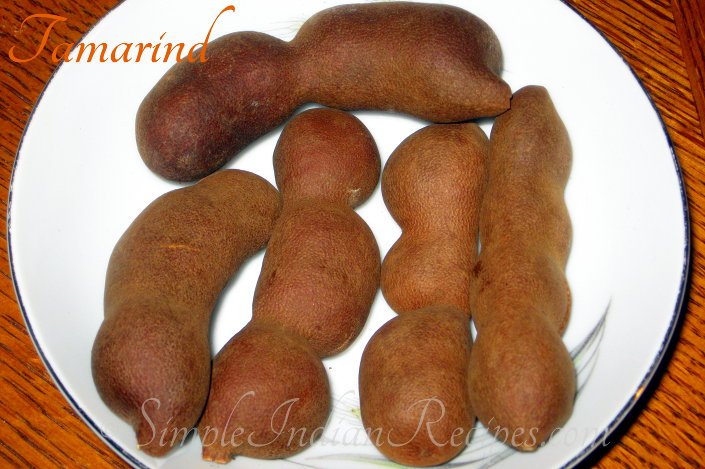(Puli, Imli, புளி)

Tamarind is a fruit that is widely used in Asian cooking. It is known as imli in hindi and puli in tamil. In South India specially most curries use tamarind. It not only adds the sourness to the curry but also helps in preserving it for longer. It used to be a very common sight to see tamarind trees in every house backyard in olden days when people used to live in big independent homes.
My grandmas house also had a big tree. As kids, it was fun to take the raw tamarind fruit which used to really sour and just munch on it. We also enjoyed just chewing the tender leaves of tamarind. Paati (grandma) used to make instant chutneys and dips in her grinding stone using tamarind, salt and red chilies. Homemade tamarind candies were made by soaking the tamarind in palm sugar syrup and resting it for few days. Tender tamarind leaves were also used to make chutney and curries. During flowering season, few dishes were prepared using the flowers too. The tree trunk was used for its wood. The ripe fruit used to be harvested in season, the outer shell and seeds are removed and then used in cooking. It is one fruit that stays good for even upto two years. It is first sun dried, then a generous amount of rock salt is applied and then stored in earthen pots. It is then used for various preparations throughout the year.
These days I also see sweet tamarind from Thailand being sold in markets. They look the same as the sour ones but are sweeter as compared to the Indian ones which are very sour. The sweet tamarind is usually had as a fruit for snack. I also came across tamarind being used to prepare sauces and dips in western countries. The popular Worcestershire sauce has tamarind as the main ingredient.
Before we look into the various Indian preparations using tamarind, let us go through some more details about choosing and storing tamarind.
How to select Tamarind?
Tamarind is available throughout the year in packets. To check for the softness and freshness of tamarind, press the tamarind slightly. If it is too hard, it will not give enough pulp on soaking. - If the tamarind pods are light whitish brown it is newer stock of tamarind and is slightly sweet and gives a lightly colored pulp. If the pods are blackish brown, it has been aged enough and will yield dark colored pulp. However the older tamarind is easy on the stomach.
How to store Tamarind?
The best way of storing tamarind is in earthen jars which helps retain their color.
How to make Tamarind Pulp / Water?
To make any recipe using tamarind, tamarind water is used as the base. Steps for making tamarind water are as below: - Soak the required quantity of tamarind pods in warm water for at least 15 minutes. - After they soften, crush the pods and extract the pulp. - You could add more water and extract till all the juice is completely extracted. - Strain the water through a filter, the water obtained is known as tamarind water.
TIPS: Tamarind and salt is also used for brightening the brass and copper vessels in the kitchen.
Recipes With Tamarind